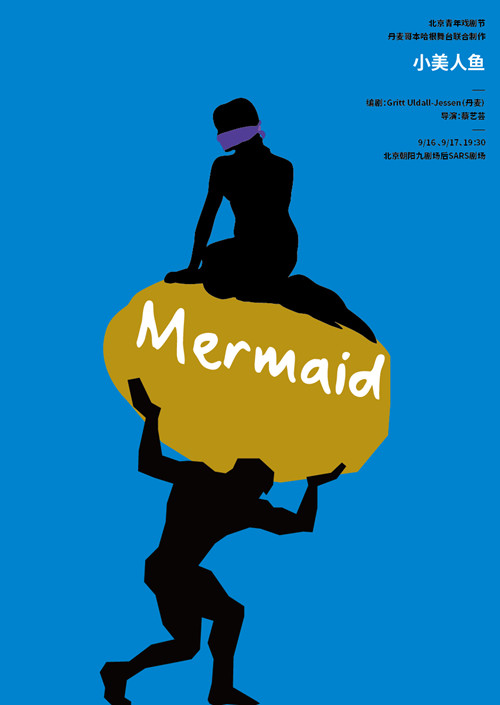小美人鱼
The Little Mermaid

类型:当代剧场作品
时长:80min
空间要求:剧场
主创团队
创作团队:歇斯底里剧团
文本:Gritt Uldall-Jessen(丹麦)
导演/戏剧构作:蔡艺芸
视觉/影像:钱泓霖
舞美:蔡艺芸
灯光:王洋
音乐:刘一纬
雕塑:刘桐
海报:郑邦谦
舞台监督:李宗霖
演员:康桐歌、李腾飞、杨金帆
Creative Ensemble: Hysteria Theater
Playwright: Gritt Uldall-Jessen(Denmark)
Dramaturgy /Director:Cai YiYun
Scenic Design:Cai YiYun
Light Design:Wang Yang
Multimedia Design:Qian HongLin
Musical Design :Liu YiWei
Cast: Kang TongGe、Yang JinFan、Li TengFei
作品介绍:
在1964年和1998年,一些匿名的艺术家,或者说激进活动家,有两次成功地锯掉了坐落在哥本哈根海边长堤公园(Langelinie)的“小美人鱼”雕像的头。另外,这雕像还曾多次被人用颜料油漆涂抹,曾被人夺走手臂,最后,(可能是借助于炸药)还被推倒过。
这出戏的出发点就是这尊雕像和它的真实故事。
安徒生关于小美人鱼的童话在这里只是一种部分的关联,或者说,一些参考点。
在文本中,我们在一种比喻的意义上谈论关于“失去头”以及关于小美人鱼的头像鬼魂一样地重归。首先,这是对应于“失去自己的一个本质部分”、“被切除了什么”的存在性经验。其次,这也是对应于“被人强行施加了某种你无法认同的东西”的经验:人们把一个形象树立在你面前,它阻碍你去看见你的前景,同时又使得别人没有办法看见本真的你自己。这样的事情在这个故事里发生了两次。
在小美人鱼空洞的内在之中,也就是说,在她的内在原型之中,居住着一个脆弱的形象。这一“内在的小美人鱼”可以被看成是这雕塑的灵魂,它是由许许多多联想构成的,诸如美人鱼、女人、爱等等的概念在我们心中呼唤出的那些联想。
这个形象成长着,并且不断地直面这外在世界。同时,外在的坚硬表象则变得柔软。
在某个时刻,它开始把自己从石头中解放出来,这时,我们就离开了这个人物形象。
这一文本是诗意文本,加上一些文字摘选,摘自雕像的历史、各种文章和讨论,同时也有一些出自安徒生童话中的引文(译者说明:剧本之中的打引号的楷体文字段落都是出自安徒生童话《海的女儿》的引文。中文摘自叶君健版译文)。
这部戏将会是一个由许多声音来讲述的独白,并且能够有至少三个、至多六个不同的表演者。它被分成12场,长度有差不多50分钟。
(译者按:剧本之中的“男/女”这个人物还有一种男变女的变性人的暗示。美人鱼的尾巴暗示为男性生殖器,他不割除男性生殖器就无法隐瞒住自己是男人的真相,而他变为女性就意味要割除这尾巴……)。
Synopsis for the monologue ’It Hurts, said the Mermaid’ by Gritt Uldall-Jessen:
Anonymous artists and/or activists have two times - in 1964 and 1998 - succeeded in cutting the head of the sculpture of the Little Mermaid on the harbour Langelinie in Copenhagen, Denmark. In addition the sculpture has been overpainted several times, robbed for an arm and latest - been overturned by the use of explosives. The sculpture with its real history is the point of departure for the story.
The story of the little Mermaid by Hans Christian Andersen is here just a part of the context/point of reference.
The text is metaphorically speaking about "losing ones head" and in the text these heads will return as a kind of ghosts. This corresponds to an existential experience of losing a crucial part of yourself, to be "amputated" by something that changes your life completely. In this story this has happened twice.
When the mermaid in 1964 first lost her head and got a new one, it changed her. She could not recognize herself or find out what she should do. In 1998 the new head is also being cut off, but it returns a few days later.
She is distraught over the loss, the new head do not suit her, and she wonder, if she would be better off without the head?
The inside of the mermaid is inhabited by a delicate creature. This "inner mermaid" can be seen as the soul of the sculpture, as the vast amount of connotations about mermaids, women and love. She relates to the sculpture as a form.
This character grows and becomes stronger from being confronted with the world outside, while the hard outer surface becomes softer.
We leave the sculpture in a state where she has started to free herself from the stone.
The text will be a monologue, combined with excerpts of the history of the sculpture, articles, comments and discussions, together with quotes from the fairy tale.
The play will be a monologue for many voices and can have up to three-four-five performers, is structured in 12 scenes, and the duration will be 50 min.
导演阐述:
由丹麦女艺术家格利特创作的文本《小美人鱼》因其独特的构思和语境给导演留出了丰富的创作空间,导演初步构思为将该作品置于一空旷的空间,将空间分割成若干个小的空间,在每一个小的空间内进行不同媒介的尝试和创作,结合影像装置、照片装置、声音互动、戏剧表演等表现手段,将《小美人鱼》这个文本里体现的“女性主义、政治性、历史性”等多个维度的东西传递给观众。在一个小时的时间里,小美人鱼雕塑所经历的历史性时间与现实性时间同步,也就是在观众走进展厅的那一刻,他(她)就与“小美人鱼”这一雕塑代表的主体产生了某种链接,当他(她)走出展厅的那一刻,观众将意识到,他(她)已经经历了前所未有的观剧体验,在这一作品中,与传统的戏剧作品的差别在于,表演只是其中的某一个部分,我们将开发观众的多个感官系统,听觉、味觉、视觉等,观众将不再只是观看与被动接受的客体,在无形的潜移默化中,观众与作品产生互动,从而更好的参与到创作中来。
Description of the concept for the staging of the performance "The Little Mermaid":
The text "”It Hurts”, Said The Mermaid”, written by the Danish playwright Gritt Uldall-Jessen, has left plenty of room for interpretation for the director because of its post-dramatic style, dealing with the inner life of the statue of The Little Mermaid at Langelinie in Copenhagen, Denmark. The initial idea of the director is to stage the piece in an empty space that then will be divided into several smaller rooms, and then carry out various experiments in each of the rooms, making use of mixed media such as combining video-installation, photo-installation, audio-interaction and performance art, and in that way give a visual expression of the multifacetted feminist, political and historical content of the text to the audience. Within an hour the historical events of the mermaid-sculpture interferes with the real time of the performance. The intention is that you as an audience member will be able to connect to the story behind the mermaid-sculpture by Hans Christian Andersen right away after having entered the exhibition room. When you come out of the exhibition room, you are going to be aware of that you might have experienced a piece of postdramatic theater like you have never experienced it before. This work will be significantly different from the traditional work of drama since the written play is only one part of the work and it also serves only as a point of departure side by side with the reference to the story of The Little Mermaid by Hans Christian Andersen and other material. The full performance is a journey involving different sensory functions of the audience, including sense of hearing, taste and sight. The audience will no longer just be adressed as an object that passively observes and receives. It will be an invisible transformation process and you as audience are invited to take part in it and interact with the performers and the different elements of the piece and find an order in it. You will find yourself involved in co-creating a piece of art work in an innovative and unpredictable way.




















